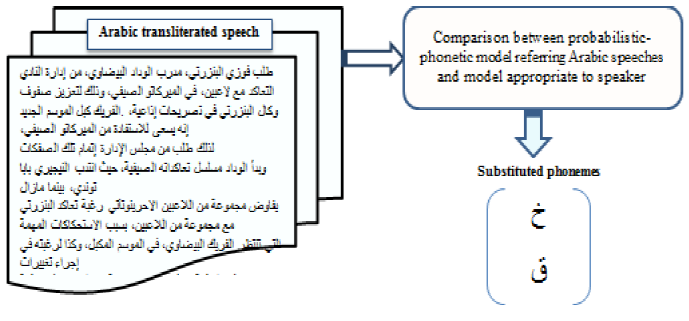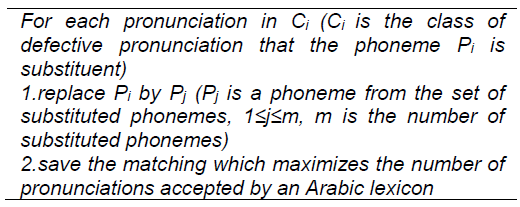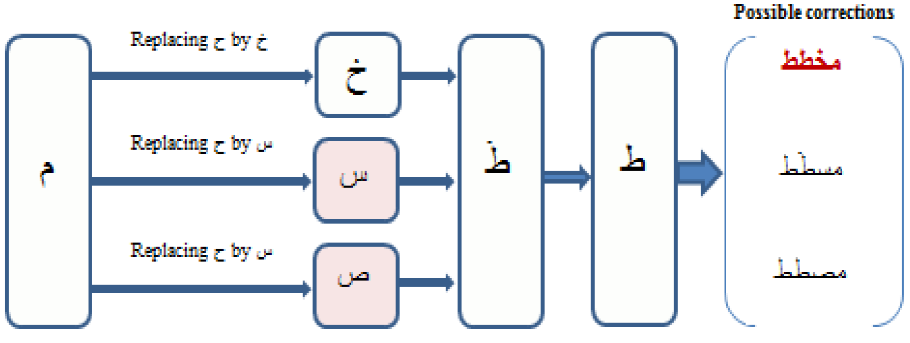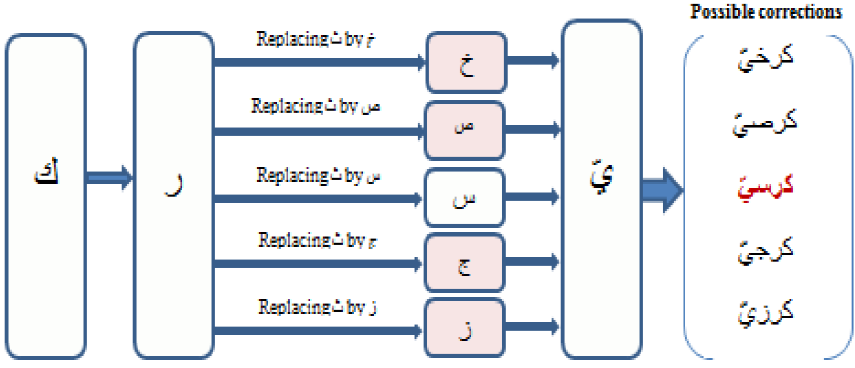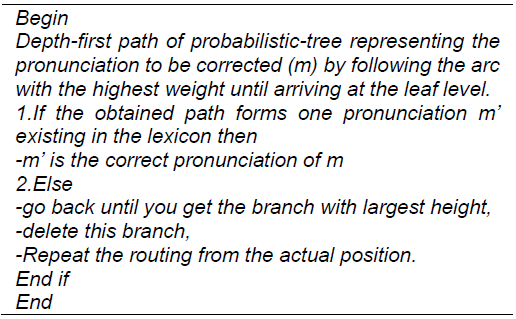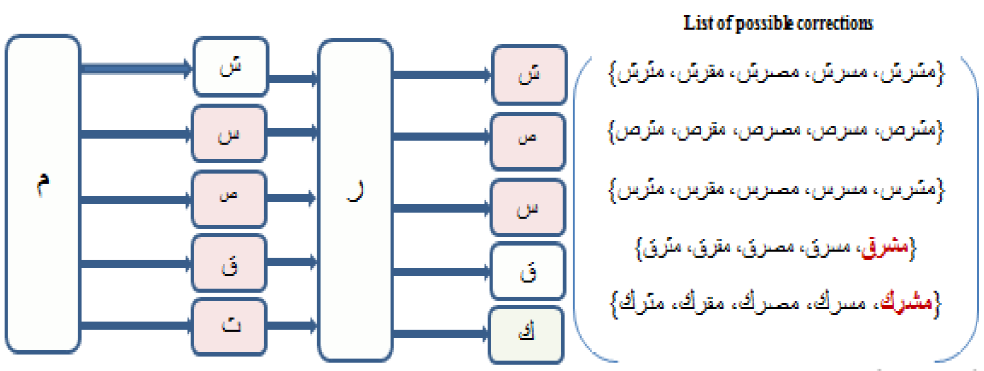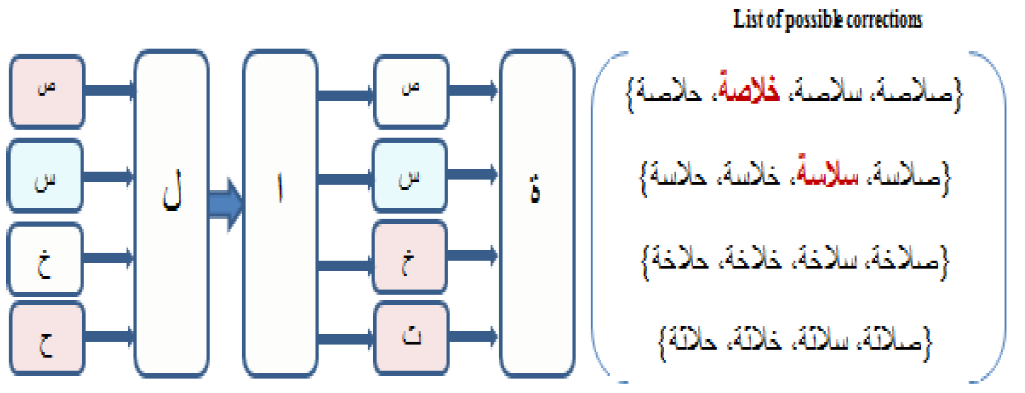1 Introduction
The human-machine communication presents a large progression and raises new challenges in the objective of comforting the dialogue conditions between humans and machines. Consequently, the literature imposes frequently new applications related to acoustic signal processing like speech recognition, vocal synthesis, speech analysis, voice anomaly detection and assistance to learners of a second language.
In spite of the diversity of techniques comforting the voice communication between humans and machines, the progressive number of people with voice disabilities presents one of the principal obstacles reducing the performance of developed applications. In order not to exclude this population from the man-machine dialogue, this study focusing on the rectification of mispronunciations contained in voice commands has been established. The basic idea is to compare between the referenced phonetic model referring to Arabic healthy speeches and the model proper to the concerned speaker.
The organization of this article is as follows. Section 2 is dedicated to excite the main problematics related to people with voice anomalies during their communication with the machine. In section 3, we cite the famous studies addressing the processing of pathological speeches. Our contribution is detailed in section 4. Section 5 is consecrated to describe the obtained experiment results. The conclusions and perspectives are listed in section 6.
2 Problematics
2.1 Arabic Vocabulary
Arabic is the language spoken by original Arabs. It counts more than 445 million speakers, ranked the 4th in the number of speakers and the 8th in the number of pages that circulate on the Internet [1].
On the one hand, and with its morphological and syntactic properties, Arabic is considered difficult to non-native learners in the area of automatic language processing [2]. On the other hand, degradations contained in produced speeches increase this difficulty. Consequently, the introduction of other means to facilitate the comprehension of defective Arabic discourses presents a necessity. Then the automatic correction of pathological speeches will take place.
2.2 Domains of Application
Human-machine communication environments provide the accessibility to information through different modes (keyboard, gestures and voice commands) according to the preferred and/or adequate manner for each user. Voice communication between humans and machines can intervene in different practical areas. We can mention:
-Voice services like the speaking clock, the weather and the reservation tickets.
- Avionics: Several airline companies introduce in the dashboard level the possibility of launching a voice command without interrupting the current task.
- Data entry like voice dictation.
- Training: Children and adults are attracted by endowed speech games (video games, educational games).
- Assistance to people with learning disabilities.
Despite diversity of practical applications involving voice human-machine communication, we mention that several factors prevent an effective dialogue. We distinguish:
- Internal factors: ambiguity [3], implicitness, language model, acoustic model.
- External factors: noise, climate, type of speech (continuous speech or single words).
- Factors due to speakers: voice disabilities, native or non-native speakers.
An erroneous pronunciation can falsify information submitted to the machine which increases the difficulty of a good communication and even falsify the desired results. Therefore, the solution is to introduce a pathological speech corrector in the machine whose functionality is to adjust received data before their treatments.
2.3 People with Language Disabilities
The statistics of the World Health Organization show that 12% of the international population (700 million people) suffers from pathologies where the voice disability is on top of the list with 30% of this population [4]. Thus, the user can communicate with the machine only after adapting this latter to consider the speaker to produce a defective speech. Consequently, the introduction of a speech correction means can provide confidence and safety to the obtained results of communication. In Table 1, we mention the percentage of each disability.
Table 1 Different disabilities with their percentages
| Pathologies | Percentage |
|---|---|
| Mental disabilities | 2.3% |
| Learning problems | 3% |
| Hearing handicaps | 0.6% |
| Visual disabilities | 0.1% |
| Physical disabilities | 0.5% |
| Behavioral disabilities | 2% |
| Language disabilities | 3.5% |
As a recapitulation, the voice communication environments are characterized by:
- The diversity of applications that involve human-machine communication applications
- The diversity of factors generating barriers of human-machine discourses
- The large number of individuals with vocal pathologies
- This population is not immune to human-machine dialogues.
Hence, the introduction of the means whose target is to detect and correct the mispronunciations contained in Arabic discourses (voice commands) can exceed these limits.
3 State of the Art
Not to eliminate people suffering from voice anomalies from vocal dialogues with machines, researchers are fully interested in establishing new methods addressing the numerical accessibility. The development of new platforms focusing on the rectification of defective pronunciations manifested in acoustic signals. From the literature, we can mention the following work:
Voice Anomalies Detection
- A novel methodology invented by Terbeh et al. in [5] whose goal was the detection of voice anomalies appeared in acoustic signals. The basic idea was to compare between different phonetic models to classify the input speech into healthy or pathological.
- In order to offer an important role in early diagnosis, progression tracking, and even the effective treatment of pathological voices, Harar et al. proposed in [11] an original approach whose aim was to detect voice pathologies contained in speech signals. The authors utilized a lot of acoustic features like the raw waveforms, the spectrograms, the Mel-frequency cepstral coefficients and the conventional acoustic features. The obtained results were around 70%.
- In [12], Muhammad et al put forward a novel method based on the interlaced derivation pattern [15], which implicated an nth directional derivative order on a spectral-temporal description of an acoustic signal. The adopted approach showed that the directional information was profitable in the detection of voice pathologies contained in Arabic vocabulary.
Speech Correction
-
- An advanced approach was elaborated by Ajibola et al. in [6] whose objective is to correct faulty pronunciations due to bad articulation or insufficient air pressure. The proposed method was based on three fundamental tasks. Firstly, the main idea consisted in suppressing the defective frames. Secondly, based on the probabilistic method, suppressed pieces were reconstructed. Finally, the authors launched the algorithm of recognizing reconstructed speeches. According to recognition results, the authors distinguished two cases:
- On the basis of speech recognition system, a novel approach was suggested in [10] by Bassil et al. An error correction method for a post-editing automatic speech recognition error correction method as well as an algorithm that was in fact based on the online spelling was proposed in this work.
The literature presents a full progression with novel studies addressing the processing of defective acoustic signals, profiting from new technologies of automatic sound processing. However, the pathological Arabic dialogues have not been treated yet. Our contribution consists, for each tagged pathological acoustic signal, in introducing new algorithms whose objective is to correct defective pronunciations.
4 Proposed Methodology
Our method focuses on three main components:
- Classification of acoustic signals into healthy or pathological
- Localization of problematic sounds for pathological speeches
- Correction of defective pronunciations
Figure 1 illustrates our method planning:
4.1.1 Probabilistic-Phonetic Model Generation
For this finality, an acoustic model and a large base of healthy Arabic speech are required. After that, this base is preprocessed; frames representing noise and non-Arabic words are suppressed. The next step consists in utilizing the Sphinx-align tool to calculate the vector summarizing the appearance probability of each Arabic bi-phoneme. The resulting vector forms the phonetic model referring to healthy Arabic speeches.
4.1.2 Scalar Product in ℜn
The scalar product in ℜn, noted by <x|y>, is the function which associates to the vectors x=(x1, x2, xn)εℜn and y=(y1, y2,…yn) εℜn the quantity:
This quantity can also be expressed as follows:
We note by:
- θ the angle which separates the two vectors x and y,
-
-
Consequently, we can deduce that:
If we can generate a vectorial representation in ℜn for each produced speech signal, angle θ (equations (1) and (2)) can be used as a measure of similarity between the speech signals represented by these vectors. Indeed, the similarity between different acoustic signals is proportional to the angular distance (angle θ) which separates between the representative vectors.
4.1.3 Phonetic Distance
In this work, the notion of phonetic distance is invented for the first time. It describes the angular distance that separates two different phonetic models. In order to calculate the phonetic distance, n healthy speech bases are required. These bases are treated as follows:
- For each corpus Ci (i=1-n), we calculate the equivalent probabilistic-phonetic model Mi.
- S={αij; 1≤i, j≤n and i≠j} contains all angles separating two different models Mi and Mj.
- Max defines the maximum of the ensemble {S}.
- δ defines the standard deviation of {S}.
- Avg defines the average of {S}.
- The phonetic distance is defined by this expression: β=Max+|Avg-δ|.
4.1.4 Speech Classification
Each input speech undergoes two different decisions; it will be classified into healthy or pathological. The generated decision depends on the phonetic distance θ which separates between the probabilistic-phonetic model referring the healthy Arabic spoken vocabulary and the model characterizing the input speech recorded by a new speaker (native, non-native, healthy, with voice anomalies). Two cases are envisaged:
4.2 Correction Procedure
Correction procedure is based on two fundamental tasks. The first consists in identifying the problematic sounds (sounds begetting the voice anomalies and replacement ones). Based on identified phonemes in the first task, the second one will be dedicated for the matching between problematic sounds to generate the correct pronunciation corresponding to each faulty one.
4.2.1 Problematic Sound Identification
The current procedure will be applied only if the input acoustic signal contains voice anomalies and classified as defective. The proposed algorithm of identifying problematic sounds generates two main phoneme categories (substituted phonemes and substituent ones).
4.2.1.1 Substituted Sounds
This category of sounds prevents the correct pronunciation and presents the source of voice anomalies for the concerned talkers. The suggested algorithms whose aim is to identify these sounds are based on the hypothesis considering that one substituted phoneme does never figurate in the phonetic transcription summarizing the input speech. Accordingly, all coefficients of probabilistic-phonetic model corresponding to bi-phonemes containing a faulty produced sound will be equal to zero.
On the basis of the previously mentioned hypothesis, a simple comparison between the probabilistic-phonetic model referring to the Arabic healthy speech and the probabilistic-phonetic model proper to speaker can lead to the extraction of sounds posing degraded speeches. Figure 2 illustrates the obtained results for one practical case where the speaker suffers from the pronunciation of the Arabic sounds "خ/x” and "ؾ/q".
4.2.1.2 Substituent Sounds
This subsection treats the objective of identifying substituent sounds. These latter are phonemes that are pronounced instead of substituted ones. This finality is based on the hypothesis considering that the sum of occurrence probabilities of bi-phonemes containing substituted sounds will be distributed to bi-phonemes covering replacement sounds. Therefore, all coefficients of the probabilistic-phonetic model covering bi-phonemes containing a substituent sound will present a remarkable increase compared to the referenced probabilistic-phonetic model. Figure 3 shows the obtained results for the previous example (in Figure 2):
4.3 Defective Speech Correction
In this subsection, we give details of the proposed algorithms addressing the correction of pathological speeches. We distinguish two different correction procedures according to the type of pathological speech to be corrected: homogeneous or heterogeneous classes of defective speeches.
4.3.1.1 Procedure
Homogeneous classes cluster the pronunciations containing just one faulty pronounced phoneme in each one. The correction of one defective pronunciation contained in a homogeneous class necessitates just one possible substitution of the replacement phoneme, which appears in this pronunciation by one of the substituted phonemes. The correction of mispronunciations contained in this class follows Algorithm 1:
4.3.1.2 Practical Examples
First Example
Let us take the example of the correction of the pronunciation “ ”, where:
”, where:
On the basis of the proposed solution in Algorithm
1, and applying possible matchings between problematic sounds, the
pronunciation “ ”
(planning) is calculated as a correct one which corresponds to the input
elocution. The colored pronunciation in Figure
4 presents the accepted one (the other pronunciations are not
accepted because they do not belong to the Arabic lexicon).
”
(planning) is calculated as a correct one which corresponds to the input
elocution. The colored pronunciation in Figure
4 presents the accepted one (the other pronunciations are not
accepted because they do not belong to the Arabic lexicon).
Second Example
Let us take the correction of the badly pronunciation " ", considering the
following conditions:
", considering the
following conditions:
Supporting Algorithm 1, we have obtained
the tree as shown in Figure 5. The
pronunciation “ ”
(chair) (the colored pronunciation) is calculated as the correct one, which
corresponds to the badly input elocution.
”
(chair) (the colored pronunciation) is calculated as the correct one, which
corresponds to the badly input elocution.
4.3.2 Correction of Heterogeneous Classes
Dissimilar classes assemble the mispronunciations covering more than one badly pronounced sound in each one. The correction of a pronunciation contained in a heterogeneous class requires (n+1)m-1 substitutions between the substitute phonemes that appear in this pronunciation and the substituted phonemes. In order to facilitate the management of these matchings, we introduce for this treatment the decision trees. We note by:
- n the number of substituted phonemes
- m the number of replacement phonemes that figurate in the defective pronunciation
In this class, the correction of badly pronunciations is based on Algorithms 2 and 3.
4.3.2.1 Tracing Algorithm
In order to be able to manage the very high number of substitutions between substituted phonemes and substituent ones, we propose a probabilistic-tree structure; the nodes are labeled by the phonemes and the arcs connecting these nodes are weighted by the probabilities of occurrence of the bi-phoneme [Phoneme Father-Phoneme Son].
We suggest the tracing procedure to ensure drawing the probabilistic-tree representing all possible pronunciations coming from the faulty input one:
4.3.2.1 Routing Algorithm
After drawing all possible pronunciations coming from the badly input one, the routing procedure will be used in browsing the probabilistic-tree and in calculating the list of Arabic words that correspond to the falsely pronounced ones. Details of this algorithm are as follows:
4.3.2.1 Practical Examples
First Example
Let us take the correction of the badly pronunciation “ ”, considering the following
conditions:
”, considering the following
conditions:
- Substituted phonemes={ښ،س،ص،ق}
- Substituent phonemes={ث،ك}.
-
- Possibilities of substitution between substituted phonemes and substituent ones are:
S1: ث can be a replacement phoneme of the phoneme "س".
S2: ث can be a replacement phoneme of the phoneme "ص.
S3: ث can be a replacement phoneme of the phoneme "ق".
S4: ث can be a replacement phoneme of the phoneme "س".
S5: ك can be a replacement phoneme of the phoneme "س".
S6: ك can be a replacement phoneme of the phoneme "ص".
S7: ك can be a replacement phoneme of the phoneme "ق".
S8: ك can be a replacement phoneme of the phoneme "ص".
In the current case, the badly pronunciation "ۺ؍ڭ" contains the substituent sounds “ٽ” and “ك” Applying the possible substitutions, the tracing algorithm will generate the probabilistic-tree as depicted in Figure 6:
We apply thereafter the routing algorithm to find two correct pronunciations,
accepted by the Arabic lexicon, “ ” (the orient) and
“
” (the orient) and
“ ”
(polytheist). The adequate correction from the obtained ones is the
pronunciation following the same rhyme compared to the input badly pronounced
one. The other pronunciations are not accepted by the reference lexicon, so they
are not selected.
”
(polytheist). The adequate correction from the obtained ones is the
pronunciation following the same rhyme compared to the input badly pronounced
one. The other pronunciations are not accepted by the reference lexicon, so they
are not selected.
Second Example
Let us take the correction of the badly pronunciation “ ”, considering the following
conditions:
”, considering the following
conditions:
- M={ځ،س،ص}.
- R={ح،ث}.
-
- Possibilities of substitution between substituted phonemes and substituent ones are:
S1: “ث” can be a replacement phoneme of the phoneme "س".
S2: “ث” can be a replacement phoneme of the phoneme "ص".
S3: “ث” can be a replacement phoneme of the phoneme "ځ".
S4: "ح" can be a replacement phoneme of the phoneme "س".
S5: "ح" can be a replacement phoneme of the phoneme "ص".
S6: "ح" can be a replacement phoneme of the phoneme "ځ".
In this case, phonemes "ح" and "ث" appear in the bad pronunciation “ﺨﺁﺰﺌﺔ”. Based on possible substitutions, the tracing algorithm will generate the probabilistic-tree detailed in Figure 7.
Applying the routing algorithm, we find two possible correct pronunciations
“ ”
(conclusion) and “
”
(conclusion) and “ ” (smoothness). They are accepted by the Arabic lexicon. To select the
adequate correction from the obtained ones, we can utilize semantic analysis. It
may be possible also to choose the correction with the pronunciation rhyme
similar to the input mispronunciation. The other pronunciations are not chosen
because they are not accepted by the reference lexicon.
” (smoothness). They are accepted by the Arabic lexicon. To select the
adequate correction from the obtained ones, we can utilize semantic analysis. It
may be possible also to choose the correction with the pronunciation rhyme
similar to the input mispronunciation. The other pronunciations are not chosen
because they are not accepted by the reference lexicon.
Third Example
Let us take the correction of the badly pronunciation “ ”, considering the following
conditions are:
”, considering the following
conditions are:
- M={خ،ص،س}.
- R={ح،ث}.
-
- Possibilities of substitution between substituted phonemes and substituent ones are:
S1: “ث” can be a replacement phoneme of the phoneme "س".
S2: “ث” can be a replacement phoneme of the phoneme "ص ".
S3: “ث” can be a replacement phoneme of the phoneme "ځ".
S4: "ح" can be a replacement phoneme of the phoneme "س".
S5: "ح" can be a replacement phoneme of the phoneme "ص".
S6: "ح" can be a replacement phoneme of the phoneme "خ".
The falsely pronunciation " " contains the two
phonemes "ح" and “ث” Applying the possible substitutions, the tracing
algorithm will generate the probabilistic-tree illustrated by Figure 8.
" contains the two
phonemes "ح" and “ث” Applying the possible substitutions, the tracing
algorithm will generate the probabilistic-tree illustrated by Figure 8.
Thus, we apply the routing algorithm to obtain the correct elocution
" "
(tortoise) (the colored pronunciation) corresponding to the input falsely
pronounced one.
"
(tortoise) (the colored pronunciation) corresponding to the input falsely
pronounced one.
5 Tests and Results
5.1 Data of Tests and Obtained Results
In order to test the proposed method, a large base of Arabic healthy and pathological speeches is required. For this finality, we collaborate with all members of our laboratory1 to collect 14 hours of pathological speeches and 6 hours of healthy speeches. The collected base covers different areas like technology, education, economy, sports, sciences, migration and politics. The results of pathological speech correction are detailed in Table 2:
Table 2 Summary of test base and obtained elocution-speed for each speaker
| Speaker | Area | Gender | Age (year) |
Duration (min) |
Type of speech |
Nbr. of defective pronunciations |
Problematic sounds |
Correction rate (%) |
|---|---|---|---|---|---|---|---|---|
| 01 | M | 32 | 16 | Healthy | Classified as healthy | |||
| 02 | M | 19 | 33 | Pathological | 211 | س، ص (sˤ, s) | 88.62 | |
| 03 | M | 22 | 21 | Pathological | 147 | خ، غ (ɣ, x) | 87.75 | |
| 04 | Technology | M | 41 | 25 | Pathological | 169 | س، ص (sˤ, s) | 89.34 |
| 05 | F | 26 | 22 | Healthy | Classified as healthy | |||
| 06 | F | 17 | 19 | Pathological | 143 | ر (r) | 87.41 | |
| 07 | F | 21 | 24 | Pathological | 167 | ش، س، ص (sˤ, s, ʃ) | 89.82 | |
| 08 | M | 25 | 15 | Healthy | 62 | ذ، ض، ظ (ðˤ, dˤ, ð) | 91.93 | |
| 09 | M | 23 | 32 | Healthy | Classified as healthy | |||
| 10 | M | 18 | 16 | Pathological | 129 | ر (r) | 93.02 | |
| 11 | Education | M | 32 | 23 | Pathological | 63 | ش (ʃ) | 85.71 |
| 12 | M | 39 | 27 | Pathological | 137 | ق (q) | 90.51 | |
| 13 | F | 27 | 24 | Healthy | Classified as healthy | |||
| 14 | F | 18 | 31 | Pathological | 239 | ر (r) | 92.46 | |
| 15 | F | 20 | 18 | Pathological | 117 | س، ص (sˤ, s) | 87.17 | |
| 16 | M | 30 | 20 | Healthy | Classified as healthy | |||
| 17 | M | 21 | 27 | Pathological | 59 | ث (θ) | 88.13 | |
| 18 | Economy | M | 27 | 23 | Pathological | Classified as healthy | ||
| 19 | M | 19 | 30 | Pathological | 43 | ر (r) | 93.02 | |
| 20 | F | 36 | 19 | Healthy | Classified as healthy | |||
| 21 | F | 22 | 32 | Pathological | 227 | ر (r) | 90.30 | |
| 22 | M | 24 | 14 | Healthy | 89 | س، ص (sˤ, s) | 91.01 | |
| 23 | M | 20 | 31 | Healthy | Classified as healthy | |||
| 24 | M | 19 | 33 | Pathological | 106 | ش (ʃ) | 93.39 | |
| 25 | M | 31 | 27 | Pathological | 186 | س، ص (sˤ, s) | 90.86 | |
| 26 | Sports | M | 42 | 29 | Pathological | 204 | خ، غ (ɣ, x) | 92.64 |
| 27 | M | 17 | 23 | Pathological | 121 | ق (q) | 93.38 | |
| 28 | F | 21 | 21 | Healthy | Classified as healthy | |||
| 29 | F | 24 | 26 | Pathological | 173 | س، ص (sˤ, s) | 87.86 | |
| 30 | F | 38 | 19 | Pathological | 141 | خ، غ (ɣ, x) | 91.49 | |
| 31 | M | 20 | 19 | Healthy | Classified as healthy | |||
| 32 | M | 16 | 25 | Pathological | Classified as healthy | |||
| 33 | Sciences | M | 29 | 19 | Pathological | 152 | ر (r) | 92.76 |
| 34 | M | 27 | 31 | Pathological | 229 | س، ص، ق (q, sˤ, s) | 92.13 | |
| 35 | F | 31 | 28 | Healthy | Classified as healthy | |||
| 36 | F | 18 | 23 | Pathological | 159 | خ، غ (ɣ, x) | 92.45 | |
| 37 | F | 44 | 25 | Pathological | 119 | ق (q) | 89.91 | |
| 38 | M | 32 | 22 | Healthy | Classified as healthy | |||
| 39 | M | 25 | 23 | Pathological | 46 | ث (θ) | 89.13 | |
| 40 | M | 22 | 19 | Pathological | 156 | س، ص، ق (q, sˤ, s) | 91.02 | |
| 41 | Migration | M | 34 | 28 | Pathological | 125 | ذ، ض، ظ (ðˤ, dˤ, ð) | 93.60 |
| 42 | F | 19 | 27 | Healthy | Classified as healthy | |||
| 43 | F | 23 | 17 | Healthy | Classified as healthy | |||
| 44 | F | 18 | 29 | Pathological | 204 | ش، س، ص (sˤ, s, ʃ) | 91.66 | |
| 45 | M | 43 | 22 | Healthy | Classified as healthy | |||
| 46 | M | 18 | 28 | Pathological | 117 | ذ، ض، ظ (ðˤ, dˤ, ð) | 89.74 | |
| 47 | M | 34 | 17 | Pathological | 113 | خ، غ (ɣ, x) | 92.03 | |
| 48 | Politics | M | 40 | 20 | Pathological | 89 | ق (q) | 83.14 |
| 49 | M | 38 | 18 | Pathological | 109 | ر (r) | 91.74 | |
| 50 | M | 31 | 19 | Pathological | Classified as healthy | |||
| 51 | F | 25 | 16 | Healthy | 127 | ر (r) | 88.18 | |
| 52 | F | 32 | 15 | Pathological | 69 | ذ، ض، ظ (ðˤ, dˤ, ð) | 81.15 |
Table 3 Arabic to IPA mapping (consonants)
| Arabic consonants | IPA symbol | English approximation |
|---|---|---|
| ا, ى | a: | father |
| ب | b | bee |
| د | d | dash |
| ض | dˤ | like the sound d in duck, bud, nod |
| ج | dʒ | jam |
| ذ | ð | these |
| ظ | ðˤ | no English equivalent (like voiced th) |
| ف | f | father |
| ه | h | who |
| ح | ħ | No English equivalent, (like Mexican jota) |
| ي | j | yes |
| ك | k | skin |
| ل | l | tool |
| م | m | me |
| ن | n | no |
| ق | q | no English equivalent (emphatic /k/) |
| ر | r | rhythm |
| س | s | see |
| ص | sˤ | son |
| ش | ʃ | she |
| ت | t | table |
| ط | tˤ | like the sound t in bottle |
| ث | θ | think |
| و | w | we |
| خ | x | no English equivalent (Spanish jota) |
| غ | ɣ | no English equivalent (Spanish fuego) |
| ز | z | zoo |
| ظ | zˤ | no English equivalent (emphatic /z/) |
| ء | ʔ | no English equivalent (like aim) |
| ع | ʕ | no English equivalent |
The obtained results, shown in Table 2, present the efficiency of our pathological speech corrector. Figure 9 depicts the speech classification and the defective speech correction rates for each gender and for each type of speeches (healthy and pathological).
5.2 Discussion and Limits
Table 2 presents some misclassifications; i.e. a healthy speech classified as a pathological one and vice versa. These bad classifications can be due to the following reasons:
- The concerned speakers do not suffer from voice pathologies, but they present some difficulties in mastering the pronunciation of some phoneme combinations like the succession of two emphatic phonemes, the succession of thin and amplified sounds. In such cases, and the speaker presents some phoneme outlet troubles.
- The speaker suffers from distorted voice pathologies. In such a case, the desired sound is badly pronounced, but the substituent phoneme is nevertheless like the hoped sound. For example, the concerned speaker can produce the defective pronunciation
 (with a voiceless /t/) instead of the desired
(with a voiceless /t/) instead of the desired  (with a voiced
/t/) (table). In this case, despite the fact that a mispronunciation
manifests, the produced speech is understandable, especially in
human-human communication.
(with a voiced
/t/) (table). In this case, despite the fact that a mispronunciation
manifests, the produced speech is understandable, especially in
human-human communication.- For several speakers, we can also justify misclassifications by the rhythm of elocution. Indeed, speakers who talk quickly may merge two or more phonemes, which can influence the proper resulting probabilistic-phonetic model. Consequently, the comparison between the phonation model referring to Arabic vocabulary and the elocution model specific to the speaker will generate erroneous results and the produced speech will be misclassified.
Sometimes the algorithm of defective speech correction generates several possible correct pronunciations for a single erroneous pronunciation. In such a case, semantic analysis is required to select the adequate correction. We also notice that the problematic phonemes for the same speaker are often clustered in the same category (hissing, emphatic, Occlusive, fricative, nasal, etc.)
6 Conclusions
To conclude, we can confirm that the probabilistic-phonetic modeling is a deciding factor in Arabic speech classification into healthy or pathological. This manuscript describes a novel naive algorithm whose aim is to correct bad pronunciations manifested in Arabic discourses.
We can conclude that the comparison between different phonetic models presents a deciding factor to detect vocal pathologies contained in Arabic speeches and to generate an adequate correction for each input mispronunciation. In this paper, we have proposed a novel algorithm to correct mispronunciations contained in an Arabic acoustic signal.
For this purpose, a corpus of 11 hours of healthy Arabic speeches has been prepared for calculation of the phonetic model referring to the spoken Arabic language.
On the basis of 52 speech sequences recorded by male and female native speakers covering healthy and pathological speeches, the suggested methodology has attained high speech classification accuracy. Indeed, the algorithm whose target is to classify input speeches into healthy or pathological has a classification rate of 88%. For each speech sequence classified as pathological, we launch a naïve algorithm based on testing all possible substitutions that can be applied between substituted and substituent sounds.
We distinguish for each substitution two decisions: If the resulting pronunciation is accepted by an Arabic lexicon, then we will save this matching.
Otherwise, the substitution will not be suitable, so we will try with another analogous one. By its obtained correction rate reaching 90%, the proposed algorithm addressing the correction of defective pronunciations has presented high efficiency.
The contribution detailed in this article presents one of the profitable correctors of defective speeches.
Indeed, to the best of our knowledge, it is the first attempt addressing the rectification of vocal anomalies contained in the Arabic speeches in the purpose of facilitating the accessibility to the numerical information in the natural language processing domain. As concluding remarks, the obtained results are satisfactory and our proposition can be applied in others related studies.
As any research work, our contribution presents some limits. Consequently, we can put forward a phase of semantic analysis that can assist the defective-speech corrector to select the appropriate correction that corresponds to the desired meaning.
As perspectives, we can benefit from this work to elaborate new systems addressing the assistance to scholar children suffering from voice disabilities [13,14,17]. It may be possible also to use other features like the voyellation and the pronunciation rhymes for guiding the correction of degraded acoustic signals.











 nova página do texto(beta)
nova página do texto(beta)


